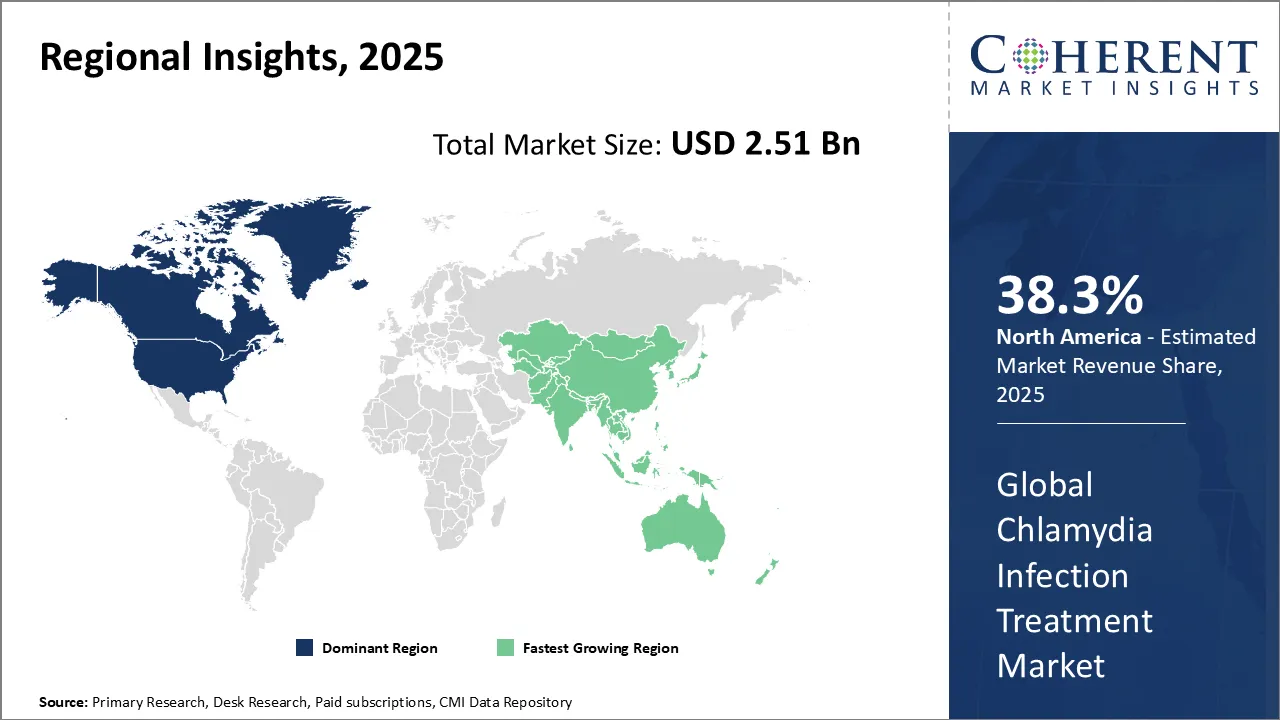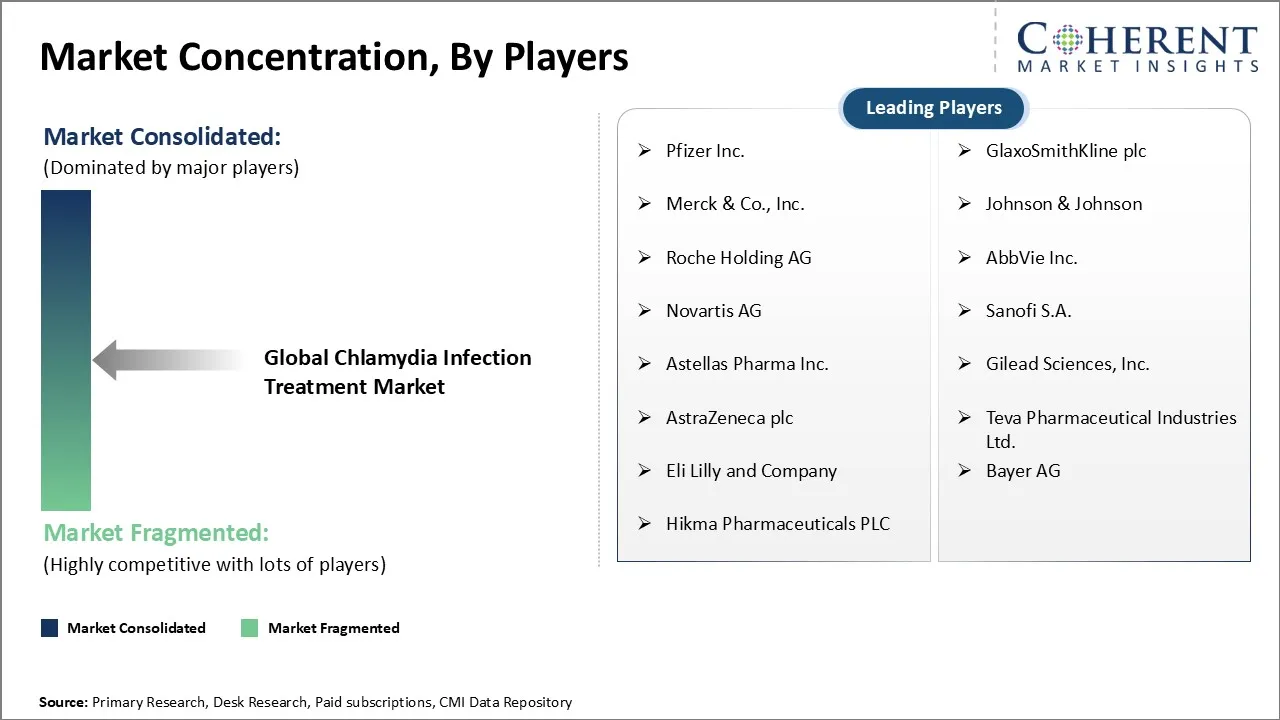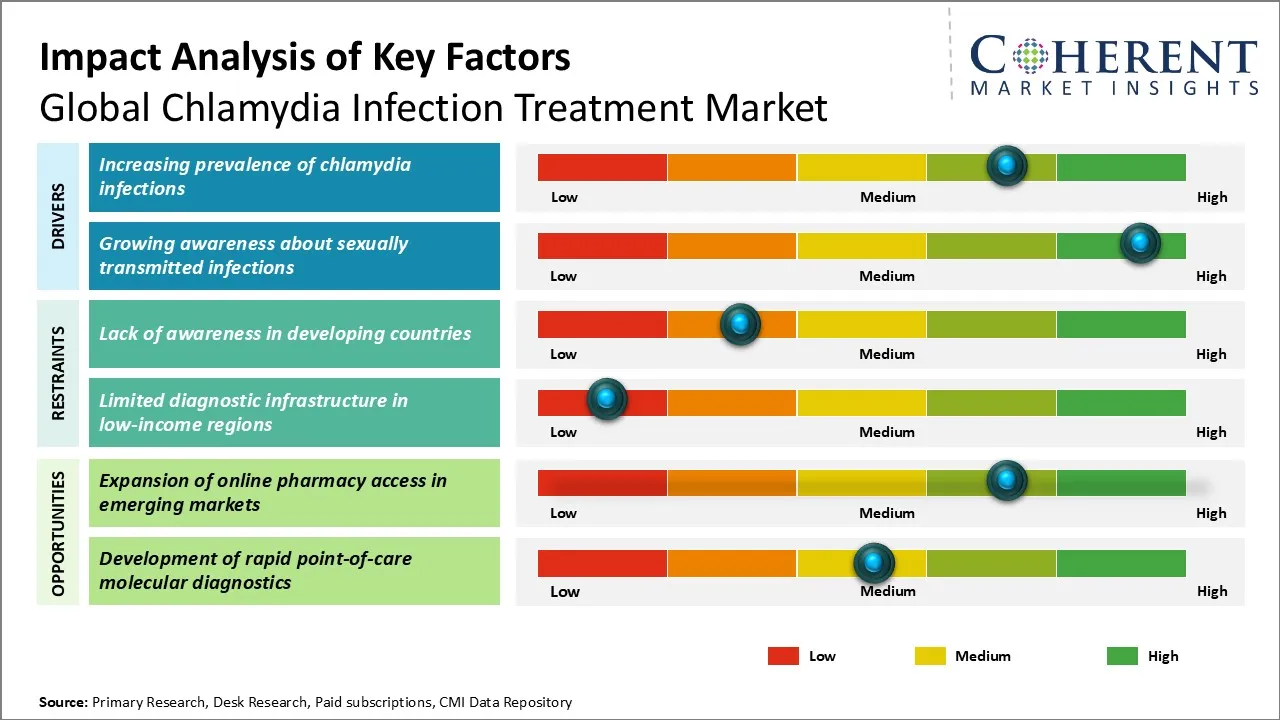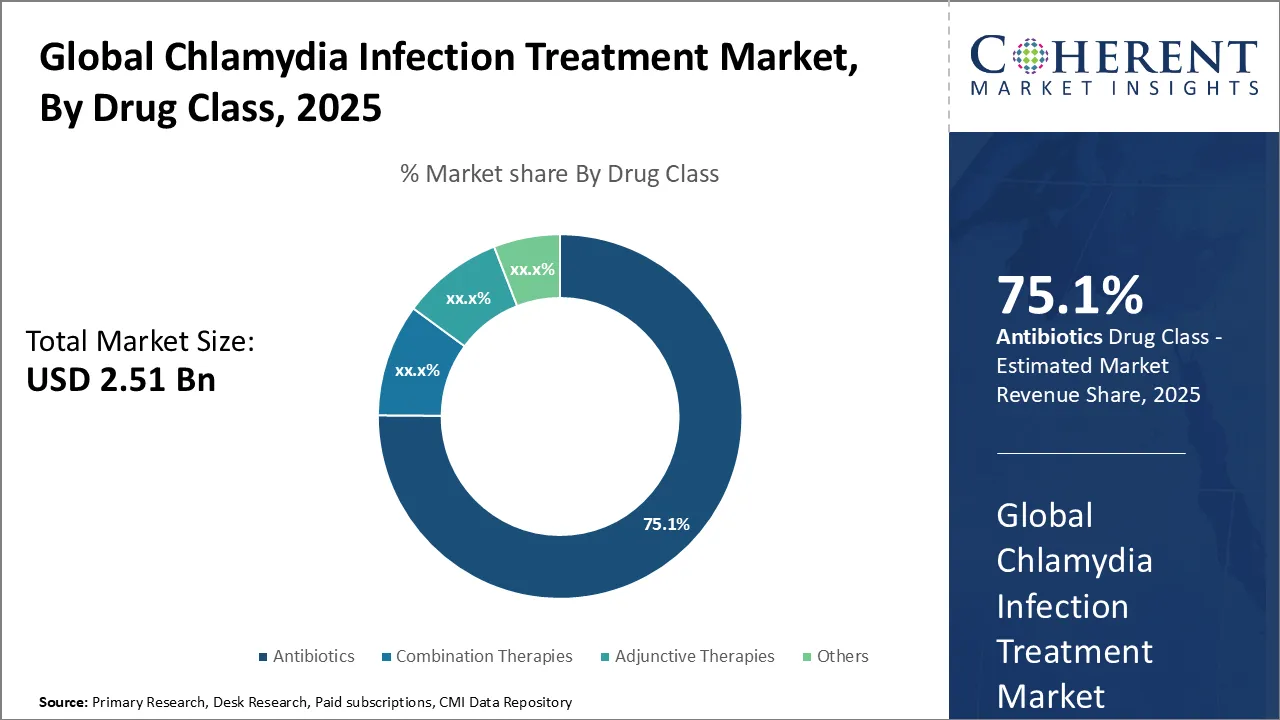Global Chlamydia Infection Treatment Market Size and Forecast – 2025 to 2032
The Global Chlamydia Infection Treatment Market is estimated to be valued at USD 2.51 Bn in 2025 and is expected to reach USD 3.56 Bn by 2032, exhibiting a compound annual growth rate (CAGR) of 5.1% from 2025 to 2032. This steady growth reflects increased awareness, improved diagnostics, and expanding access to effective treatment options worldwide, particularly in high-prevalence regions. The market dynamics are driven by rising incidences and government initiatives supporting sexual health programs, contributing to expanded market penetration.
Key Takeaways of the Global Chlamydia Infection Treatment Market
- In the global chlamydia infection treatment market, antibiotics remain the dominant drug class, accounting for an estimated 75.1% of the market share in 2025.
- By route of administration, oral delivery methods lead the market, representing an estimated 50.1% of total share in 2025.
- From an age group perspective, the pediatric segment is expected to hold the largest share at 34.4% in 2025, primarily driven by growing awareness initiatives and expanded screening programs targeting younger populations.
- North America is expected to lead the market, holding a share of 38.3% in 2025. Asia Pacific is anticipated to be the fastest-growing region, with a market share of 25.3% in 2025.
Market Overview
Current trends in the chlamydia infection treatment market emphasize the adoption of advanced antibiotic regimens and the development of novel therapeutics to combat resistance issues. Additionally, digital health technologies and telemedicine platforms are playing a significant role in enhancing patient outreach and treatment adherence. Preventive strategies, including vaccination research and public health campaigns, are gaining prominence. Furthermore, increased funding in sexual health and rising healthcare infrastructure investments in emerging markets are expected to bolster market growth during the forecast period.
Current Events and Its Impact
|
Current Events |
Description and its impact |
|
2025 European Treatment Guidelines Update |
|
|
Technological Advancements in Diagnostics |
|
Uncover macros and micros vetted on 75+ parameters: Get instant access to report
Chlamydia Infection Treatment Market Insights, by Drug Class – Antibiotics Lead the Market Due to Broad-Spectrum Efficacy and Established Treatment Protocols
In terms of drug class, antibiotics segment is expected to dominate the landscape, holding the highest market share of 75.1% in 2025. The primary driver behind this dominance is the proven efficacy of antibiotics in eradicating the Chlamydia trachomatis bacteria that cause the infection. Antibiotics such as macrolides, tetracyclines, fluoroquinolones, and aminopenicillins have been longstanding cornerstones of treatment protocols, offering reliable, well-documented therapeutic outcomes. Specifically, macrolides like azithromycin are favored for their broad-spectrum antibacterial activity and shorter treatment regimens, which improve patient compliance.
The widespread adoption of antibiotics is also fueled by their accessibility and relatively low cost, making these medications the frontline choice globally. Among antibiotics, azithromycin’s single-dose regimen enhances adherence and is particularly important in treating infections that may otherwise face challenges with patient follow-through. The availability of combination therapies, such as azithromycin with doxycycline, also reflects an innovation trend within this drug class, aiming to combat potential antibiotic resistance while maintaining treatment efficacy.
For instance, the WHO Sexually Transmitted Infection (STI) guidelines recommend treating uncomplicated genital Chlamydia trachomatis infection with either single-dose azithromycin or 7-day doxycycline, while tetracycline, erythromycin, and ofloxacin are listed as alternatives. Evidence shows trivial differences in cure rates and side effects between azithromycin and doxycycline, though azithromycin’s single dose may improve patient adherence.
Chlamydia Infection Treatment Market Insights, by Route of Administration – Oral Administration Prevails Owing to Convenience and Patient Compliance
When examining the global chlamydia infection treatment market by route of administration, oral delivery methods are expected to hold the largest share with 50.1% in 2025. The primary reason for the dominance of oral administration is the convenience and simplicity it offers to patients. Oral antibiotics can be self-administered without the need for medical supervision or specialized equipment, enabling easier access and broader reach. This route of administration is particularly crucial for sexually transmitted infections like chlamydia, where prompt and confidential treatment is essential to curb disease transmission and avoid complications.
Oral drugs such as azithromycin and doxycycline are well absorbed, providing effective systemic treatment while minimizing discomfort for the patient. The non-invasive nature of oral administration eliminates the barriers often associated with injectable (parenteral) or topical treatments, such as pain, needle phobia, or application difficulty. This ease of use promotes adherence to prescribed regimens, a critical factor in ensuring treatment success and preventing reinfection or antibiotic resistance.
Chlamydia Infection Treatment Market Insights, By Age Group – Pediatric Segment Leads Owing to Rising Awareness and Screening Initiatives
In the context of age groups within the global chlamydia infection treatment market, the pediatric segment is expected to contribute the highest share with 34.4% in 2025, driven by increased awareness and enhanced screening efforts among younger populations. Chlamydia infections in pediatric patients, particularly adolescents and young adults, represent a significant public health concern due to high infection rates correlated with risky sexual behaviors and lack of early symptom recognition. Growing educational campaigns targeting sexual health and prevention have encouraged early diagnosis and timely treatment of infections in this demographic.
Pediatric patients benefit from tailored treatment protocols that consider age-specific pharmacokinetics and safety profiles, which foster more effective and safer therapy delivery. The increasing emphasis on routine screening programs in schools, pediatric clinics, and community health settings has also heightened detection rates, thereby expanding the demand for chlamydia treatments in the pediatric category. Early treatment is critical to preventing complications such as pelvic inflammatory disease and future fertility issues, creating a strong impetus for healthcare providers and caregivers to seek prompt interventions.
Epidemiological Differences in STIs and Non STIs - Chlamydia Infection Treatment Market
- The epidemiology of STI-associated Chlamydia infections, primarily caused by Chlamydia trachomatis, is characterized by high prevalence among sexually active adolescents and young adults, especially women aged 15–24. Most cases are asymptomatic, leading to underdiagnosis and persistent community transmission. If untreated, infections can result in severe reproductive complications, including pelvic inflammatory disease, infertility, and ectopic pregnancy. Consequently, public health programs and targeted screening initiatives have been established in many countries to detect and manage these cases early, driving demand for specialized diagnostics and treatment regimens.
- In contrast, non-STI Chlamydia infections, such as those caused by Chlamydia pneumoniae or Chlamydia psittaci, follow different epidemiological patterns. These infections are typically transmitted through respiratory droplets or zoonotic exposure rather than sexual contact. They mainly affect other demographics, including older adults and individuals in close contact with birds or livestock. Unlike STI-related Chlamydia, non-STI cases often present with acute respiratory symptoms and are managed within broader infectious disease protocols, with no dedicated screening infrastructure. This divergence in transmission routes, affected populations, and clinical impact shapes the market segmentation and treatment pathways for Chlamydia infections.
Regional Insights

To learn more about this report, Download Free Sample
North America Chlamydia Infection Treatment Analysis and Trends
In North America, the dominance in the global chlamydia infection treatment market is driven by a robust healthcare infrastructure with an estimated share of 38.3% in 2025, advanced research and development capabilities, and governments worldwide run programs to promote sexual health, including public awareness campaigns, free or low-cost STI testing and treatment, HIV prevention services (PrEP and PEP), vaccination drives, and confidential clinics accessible regardless of income or immigration status.
For instance, in June 2025, The New York City Health Department, the public agency overseeing health services for over 8 million residents, launched a citywide awareness campaign promoting its Sexual Health Clinics, which offer low- or no-cost confidential care to all New Yorkers, regardless of immigration or insurance status.
The presence of leading pharmaceutical and biotech companies, such as Pfizer, GlaxoSmithKline, and Bausch Health, significantly bolsters the market with continuous innovation and an extensive portfolio of antibiotic treatments. Additionally, reimbursement policies and well-established healthcare delivery systems facilitate widespread access to treatment.
Asia Pacific Chlamydia Infection Treatment Analysis and Trends
Meanwhile, the Asia Pacific region is expected to exhibit the fastest growth in the chlamydia infection treatment market with a share of 25.3% in 2025 due to rising awareness about sexually transmitted infections, expanding healthcare access, and increasing healthcare expenditure in emerging economies like India and China. Government initiatives focused on strengthening primary healthcare systems and improving sexual health education have accelerated treatment uptake.
For instance, in November 2024, Australia invested USD 56.8 million in a new initiative to advance sexual and reproductive health and rights across Southeast Asia. The program, partnering with UNFPA, IPPF, Marie Stopes International, and UNICEF, will expand services, digital health tools, and community awareness while supporting efforts to end violence against women and girls.
The growing presence of multinational pharmaceutical companies such as Cipla, Sun Pharmaceutical, and Lupin, alongside local manufacturers, has improved availability and affordability of treatment options. Trade liberalization and improving supply chain logistics in this region also contribute to faster market growth.
Chlamydia Infection Treatment Market Outlook for Key Countries:
U.S. Chlamydia Infection Treatment Market Trends
The U.S. chlamydia infection treatment market benefits from being a highly mature and research-driven environment with significant investment in sexual health programs by organizations such as the Centers for Disease Control and Prevention and National Institutes of Health. The U.S. also leads in innovative diagnostic and treatment protocols, ensuring early detection and efficient management of chlamydia infections.
For example, Pfizer Inc. and Merck & Co., Inc. drive the market with popular antibiotics such as azithromycin and doxycycline. These efforts are supported by the Centers for Disease Control and Prevention (CDC) through its Sexually Transmitted Disease (STD) Awareness Campaign, along with research funded by the National Institutes of Health (NIH) to advance diagnostics and treatment options.
Germany Chlamydia Infection Treatment Market Trends
Germany’s robust healthcare system and emphasis on preventive care shape its Chlamydia infection treatment market. The country hosts major pharmaceutical hubs, including Bayer and Boehringer Ingelheim, which contribute to the development and distribution of effective treatment regimens. Strong government support for sexual health awareness campaigns and strict regulatory frameworks ensure high-quality standards and consistent availability of treatment options.
For example, Bayer Aktiengesellschaft (Bayer AG) produces broad-spectrum antibiotics including doxycycline formulations, while Boehringer Ingelheim GmbH manufactures generic antibiotics used in sexually transmitted infection treatment regimens. The Federal Centre for Health Education (Bundeszentrale für gesundheitliche Aufklärung, BZgA) runs the Liebesleben campaign to raise awareness and encourage early diagnosis.
China Chlamydia Infection Treatment Market Trends
China is a key driver for market expansion in Asia Pacific, supported by government policies promoting infectious disease control and sexual health awareness. Domestic companies like Jiangsu Hengrui Medicine and global players such as GlaxoSmithKline actively support the market through affordable treatment solutions and active participation in public health initiatives. Increasing urbanization and improved healthcare facilities are accelerating treatment adoption rates in the country.
For example, Jiangsu Hengrui Medicine Co., Ltd. supplies generic doxycycline and azithromycin at accessible price points, supporting broader treatment adoption. GlaxoSmithKline China (GSK China) distributes branded azithromycin and partners in public health initiatives with the National Health Commission of the People’s Republic of China to improve STI screening and education.
India Chlamydia Infection Treatment Market Trends
India’s growing healthcare infrastructure, along with government efforts to combat sexually transmitted infections through national health missions, underpins its vibrant market growth. Local pharmaceutical giants such as Cipla and Sun Pharmaceutical play a critical role by offering cost-effective and accessible treatment options. Awareness campaigns and expanding insurance coverage are improving market penetration, especially in rural and semi-urban areas.
For example, Cipla Limited and Sun Pharmaceutical Industries Limited manufacture affordable generic doxycycline and azithromycin, making treatments widely available in both public and private healthcare settings. The National AIDS Control Organisation (NACO) supports distribution and awareness programs to increase uptake, particularly in underserved areas.
Market Players, Key Developments, and Competitive Intelligence

To learn more about this report, Download Free Sample
Key Developments
- In March 2025, the U.S. FDA granted marketing authorization to Visby Medical for the Visby Medical Women’s Sexual Health Test, the first at-home diagnostic test for chlamydia, gonorrhea, and trichomoniasis. This test, available without a prescription, provides results in about 30 minutes and is designed for women, both symptomatic and asymptomatic.
- In January 2025, Roche received U.S. FDA 510(k) clearance and CLIA waiver for its cobas liat molecular tests, which allow for rapid diagnosis of sexually transmitted infections (STIs), including chlamydia, gonorrhea, and Mycoplasma genitalium. These tests provide results in just 20 minutes and can be used in decentralized settings such as urgent care centers and community health venues.
Top Strategies Followed by Global Chlamydia Infection Treatment Market
- Established market leaders consistently invest substantial resources in research and development (R&D) to innovate high-performance and efficacious products. Their R&D efforts focus on improving drug formulations, enhancing treatment efficacy, and minimizing side effects to meet evolving regulatory standards and patient needs. In addition to innovation, these players seek strategic partnerships with major pharmaceutical companies, Original Equipment Manufacturers (OEMs), and healthcare providers to consolidate their market position.
- Pfizer manufactures Zithromax (azithromycin), one of the most widely used macrolide antibiotics for chlamydia infections, while GSK maintains a robust anti-infective portfolio including doxycycline and collaborates with health organizations to expand treatment access globally
- Mid-level companies operating within the chlamydia infection treatment space adopt a distinctly pragmatic approach, centering on offering cost-effective solutions that strike a balance between quality and affordability. Their target demographic typically includes price-sensitive consumers in both developed and developing regions who require reliable treatment options without premium pricing. To compete effectively, these mid-tier players often collaborate with contract manufacturers or technology providers to enhance production efficiency and integrate advanced drug delivery systems. Such partnerships enable them to scale operations, reduce manufacturing costs, and improve product accessibility.
- Lupin Pharmaceuticals and Mylan (now Viatris) play a crucial role in the global chlamydia infection treatment market by manufacturing generic versions of first-line antibiotics, offers generic versions of azithromycin and doxycycline, making treatments more accessible in emerging markets like India and Africa.
- Small-scale players in the global chlamydia infection treatment market typically focus on carving out specialized niches through innovative product features and cutting-edge technologies. These innovators often prioritize the development of novel drug formulations, rapid diagnostic-treatment combinations, or patient-centric delivery mechanisms aimed at improving treatment adherence and outcomes. Staying competitive requires small firms to adopt the latest advancements in biotechnology, nanotechnology, or digital health to differentiate their offerings effectively.
- Specialty companies and innovators including Nabriva Therapeutics, Melinta Therapeutics, Cempra, and Cepheid focus on novel therapies and rapid diagnostics to differentiate themselves. Nabriva has developed Xenleta (lefamulin), a new pleuromutilin antibiotic approved for community-acquired bacterial pneumonia and under investigation for sexually transmitted infections like chlamydia. Melinta Therapeutics offers innovative anti-infectives such as Baxdela (delafloxacin) and continues the development of advanced formulations.
Market Report Scope
Chlamydia Infection Treatment Market Report Coverage
| Report Coverage | Details | ||
|---|---|---|---|
| Base Year: | 2024 | Market Size in 2025: | USD 5.38 Bn |
| Historical Data for: | 2020 To 2024 | Forecast Period: | 2025 To 2032 |
| Forecast Period 2025 to 2032 CAGR: | 5.1% | 2032 Value Projection: | USD 7.62 Bn |
| Geographies covered: |
|
||
| Segments covered: |
|
||
| Companies covered: |
Pfizer Inc., GlaxoSmithKline plc, Merck & Co., Inc., Johnson & Johnson, Roche Holding AG, AbbVie Inc., Novartis AG, Sanofi S.A., Astellas Pharma Inc., Gilead Sciences, Inc., AstraZeneca plc, Teva Pharmaceutical Industries Ltd., Eli Lilly and Company, Bayer AG, and Hikma Pharmaceuticals PLC |
||
| Growth Drivers: |
|
||
| Restraints & Challenges: |
|
||
Uncover macros and micros vetted on 75+ parameters: Get instant access to report
Chlamydia Infection Treatment Market Dynamics

To learn more about this report, Download Free Sample
Chlamydia Infection Treatment Market Driver - Increasing prevalence of chlamydia infections
The rising prevalence of chlamydia infections across diverse demographic groups significantly propels the demand for effective treatment options, thereby driving the global chlamydia infection treatment market. Factors such as inadequate awareness about safe sexual practices, limited access to healthcare in certain regions, and the asymptomatic nature of many infections contribute to underdiagnosed and untreated cases, which, in turn, exacerbate transmission rates. This surge in infection numbers necessitates increased screening, diagnosis, and subsequent treatment interventions, prompting healthcare providers to prioritize the management of chlamydia infections. Additionally, the growing focus on sexual health education and regular testing among sexually active populations is fostering earlier detection, which creates a sustained need for efficacious antibiotic therapies and advanced treatment protocols.
In November 2024, according to the World Health Organization, Chlamydia trachomatis remains one of the world’s most common sexually transmitted infections. In 2020, an estimated 128.5 million new infections occurred globally among adults aged 15–49. Prevalence was 4.0% in women and 2.5% in men, with the highest rates in young people. While most infections are asymptomatic, untreated chlamydia can cause infertility, pelvic inflammatory disease, and adverse pregnancy outcomes. Condom use remains the most effective prevention.
Chlamydia Infection Treatment Market Opportunity - Development of rapid point ‑of ‑care molecular diagnostics
The chlamydia infection treatment market presents significant opportunities through the development of rapid point-of-care molecular diagnostics. These innovative testing solutions enable quick and accurate detection of chlamydia, facilitating timely treatment and reducing transmission rates. By providing results within minutes rather than days, these diagnostics enhance patient convenience and improve healthcare outcomes. Additionally, their integration into various healthcare settings, including clinics and pharmacies, can increase accessibility for underserved populations, thereby addressing a critical gap in current STI management. As demand for efficient and reliable testing grows, investments in this area are likely to drive advancements and expand market potential. This initiative highlights the growing emphasis on rapid, decentralized STI diagnostics that combine advanced PCR technology with portable devices to improve detection and treatment outcomes
For instance, in May 2021, SpeeDx, an Australia-based diagnostics company specializing in molecular tests, received up to USD 1.8 million in funding from CARB-X to develop InSignia, a rapid PCR-based test that detects Chlamydia trachomatis and Neisseria gonorrhoeae infections and determines antibiotic susceptibility. The technology will be integrated into QuantuMDx’s portable Q-POC device, enabling affordable, 60-minute point-of-care testing in low-resource settings. If milestones are met, SpeeDx could receive an additional USD 1.9 million to advance this critical diagnostic tool against rising antibiotic resistance.
Analyst Opinion (Expert Opinion)
- The global Chlamydia infection treatment market is witnessing steady growth, driven by rising awareness of sexually transmitted infections, advancements in molecular diagnostic technologies, and supportive regulatory initiatives promoting early detection and treatment. The widespread adoption of nucleic acid amplification tests (NAATs), coupled with updated treatment guidelines favoring doxycycline over azithromycin, has improved clinical outcomes and spurred market expansion. Emerging opportunities include the development of rapid point-of-care diagnostic platforms, particularly in low-resource settings, and investments in digital health tools to enhance screening coverage and patient adherence. However, challenges persist around antibiotic resistance, social stigma limiting testing uptake, and regional disparities in access to diagnostics and therapeutics.
- Recent years have seen several initiatives and events shaping the market landscape. Notable examples include CARB-X funding awarded to SpeeDx for developing rapid molecular diagnostics and the CDC’s updated STI Treatment Guidelines aimed at curbing resistance and improving management protocols. Key conferences such as the International Society for Sexually Transmitted Diseases Research (ISSTDR) Congress and the European STI & HIV Conference have played a vital role in knowledge-sharing and policy formulation. Collectively, these developments are fostering innovation, strengthening global collaborations, and paving the way for more accessible and effective Chlamydia treatment solutions.
Market Segmentation
- Drug Class Insights (Revenue, USD Bn, 2020 - 2032)
- Antibiotics
- Macrolides
- Azithromycin
- Erythromycin
- Tetracyclines
- Doxycycline
- Fluoroquinolones
- Levofloxacin
- Ofloxacin
- Aminopenicillins
- Amoxicillin
- Other Antibiotics (lincosamide, etc.)
- Macrolides
- Combination Therapies
- Azithromycin with Doxycycline
- Adjunctive Therapies
- Anti-inflammatory drugs
- Others
- Antibiotics
- Route of Administration Insights (Revenue, USD Bn, 2020 - 2032)
- Oral
- Parenteral
- Topical
- Age Group Insights (Revenue, USD Bn, 2020 - 2032)
- Pediatric
- Adult
- Geriatric
- Gender Insights (Revenue, USD Bn, 2020 - 2032)
- Male
- Female
- Distribution Channel Insights (Revenue, USD Bn, 2020 - 2032)
- Hospital Pharmacies
- Retail Pharmacies
- Online Pharmacies
- Regional Insights (Revenue, USD Bn, 2020 - 2032)
- North America
- U.S.
- Canada
- Latin America
- Brazil
- Argentina
- Mexico
- Rest of Latin America
- Europe
- Germany
- U.K.
- Spain
- France
- Italy
- Russia
- Rest of Europe
- Asia Pacific
- China
- India
- Japan
- Australia
- South Korea
- ASEAN
- Rest of Asia Pacific
- Middle East
- GCC Countries
- Israel
- Rest of Middle East
- Africa
- South Africa
- North Africa
- Central Africa
- North America
- Key Players Insights
- Pfizer Inc.
- GlaxoSmithKline plc
- Merck & Co., Inc.
- Johnson & Johnson
- Roche Holding AG
- AbbVie Inc.
- Novartis AG
- Sanofi S.A.
- Astellas Pharma Inc.
- Gilead Sciences, Inc.
- AstraZeneca plc
- Teva Pharmaceutical Industries Ltd.
- Eli Lilly and Company
- Bayer AG
- Hikma Pharmaceuticals PLC
Sources
Primary Research Interviews
- Infectious disease specialists
- Clinical microbiologists
- Hospital pharmacists
- Gynecologists and urologists
- Public health program managers
- STI clinic directors
- Epidemiologists in government agencies
- Pharmaceutical regulatory affairs professionals
Government and International Databases
- World Health Organization (WHO) – Global Health Observatory
- Centers for Disease Control and Prevention (CDC)
- European Centre for Disease Prevention and Control (ECDC)
- National Center for Biotechnology Information (NCBI)
- U.S. Food and Drug Administration (FDA) – Drug Approvals Database
- Medicines and Healthcare Products Regulatory Agency (MHRA, UK)
- Australian Institute of Health and Welfare (AIHW)
- European Medicines Agency (EMA)
- UNAIDS Data and Reports
- Health Canada – Drug Product Database
Trade Publications
- The Pharmaceutical Journal
- PharmaTimes
- Pharmaceutical Executive
- PharmaVoice
- Drug Discovery & Development
- In Vivo
- Pink Sheet
- Scrip Intelligence
Academic Journals
- The Lancet Infectious Diseases
- Clinical Infectious Diseases
- Sexually Transmitted Diseases (Wolters Kluwer)
- Journal of Infectious Diseases
- Sexually Transmitted Infections (BMJ)
- PLOS Neglected Tropical Diseases
- Emerging Infectious Diseases (CDC)
- Antimicrobial Agents and Chemotherapy
- Journal of Antimicrobial Chemotherapy
- International Journal of STD & AIDS
- American Journal of Obstetrics and Gynecology
- The New England Journal of Medicine
Reputable Newspapers
- The New York Times (Health Section)
- The Guardian (Global Development / Health)
- The Washington Post (Health and Science)
- Financial Times (Pharma and Healthcare)
- The Wall Street Journal (Health Industry)
Industry Associations
- Infectious Diseases Society of America (IDSA)
- International Union against Sexually Transmitted Infections (IUSTI)
- American Sexually Transmitted Diseases Association (ASTDA)
- British Association for Sexual Health and HIV (BASHH)
- International Society for STD Research (ISSTDR)
- European Society of Clinical Microbiology and Infectious Diseases (ESCMID)
- Global Antibiotic Research & Development Partnership (GARDP)
- World Medical Association (WMA)
- International Federation of Gynecology and Obstetrics (FIGO)
Public Domain Resources
- WHO Essential Medicines List
- Cochrane Library (open-access reviews)
- Open Science Framework (OSF)
- European Surveillance System (TESSy)
- USAID Data Development Library
Proprietary Elements
- CMI Data Analytics Tool: Proprietary analytics tool to analyze real-time market trends, consumer behavior, and technology adoption in market
- Proprietary CMI Existing Repository of Information for Last 8 Years
Share
Share
About Author
Vipul Patil is a dynamic management consultant with 6 years of dedicated experience in the pharmaceutical industry. Known for his analytical acumen and strategic insight, Vipul has successfully partnered with pharmaceutical companies to enhance operational efficiency, cross broader expansion, and navigate the complexities of distribution in markets with high revenue potential.
Missing comfort of reading report in your local language? Find your preferred language :
Transform your Strategy with Exclusive Trending Reports :
Frequently Asked Questions
EXISTING CLIENTELE
Joining thousands of companies around the world committed to making the Excellent Business Solutions.
View All Our Clients


